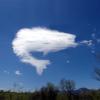First of all, I agree with WRB: My guess is what you saw was a breaching carp. They do that A LOT during their spawn. I've never seen bass leap clear unless hooked, occasionally when attacking a topwater, or chasing dragonflies (little bass). I have seen a number of anglers over the years mistaking breaching carp for bass -me included once upon a time.
Bass chasing preyfish may break top but this is usually a boil or surge, sometimes with preyfish leaping clear. Breaching carp jump clear, and often repeatedly.
S'more on "cruising bass":
In bass, cruising means swimming easily along, at or below the surface, singly or, more often, in groups. Bass do this for a number of reasons, depending on season. Cruisers are most often mentioned (with associated frustrations) in the spring. In general, bass are most catchable when feeding; Cruising is sometimes, but not always, associated with feeding.
Early spring into pre-spawn:
The first "cruisers" I see are post-winter to pre-spawn females, when still grouped up following winter. I call these cruisers parades female groups slowly cruising in a string. These I've been mostly unsuccessful catching from, but this may be that I've alarmed them. They do appear sluggish, or calm, though, and apparently not in an active hunting mode. These may be moon related too, and therefore, a (pre-mature) spawning related activity. But I'm not certain what this is yet. This tends to be an early to mid pre-spawn thing, although I did once see an apparent parade (during a full moon) associated with an intense and properly timed spawning event.
Nearer the spawn these groups tend to break up, and many may be seen cruising alone. These visible individual females, either "cruising" or holding, are heat soaking. These fish are more difficult to catch, in part because they heat soak near the surface in high visibility conditions, and also I believe, they may simply be more interested in garnering heat, then hunting.
Closer to the spawn I've found both males and females more difficult to interest in lures, in general. These late pre-spawn fish seem to be shifted less toward feeding and more toward spawning sites. They are catchable but it may take some coaxing.
Spawn:
During the very start of the actual spawning window (egg dropping) both males and females can be seen cruising, often rapidly. Males cruise widely around their beds waiting for females to corral in, what I call escorting. Females cruise spawning banks looking to be escorted in. Interestingly, I believe females light up at his time alter their color. Doug Hannon mentions seeing this in floridanus' and I believe I've seen it in northern's. They take on a vivid aqua blue-green sheen. This is a short-lived phenomenon it seems. Escorting may occur more in the evening although I've got more observing to do to see if this holds. These rapidly cruising females and soliciting males are highly excited and are both very susceptible to lures.
Late in the spawn window I often see females hanging around a bed with a locked male that's obviously guarding eggs. It's possible she will attempt to drop eggs with the male but I wonder whether the males allow it. Since egg hatching is timed with water temperature, late-dropped eggs should not be properly timed, unless the water temperature is high enough to make up the difference. Regardless, these hanger's on females as I call them, often partially spawned out, are very catchable as they cruise a lazy circuit around the bed. These fish seem less spooky than other cruisers as if doped up on hormones, or maybe, simply hungry.
From post-spawn on through summer and well into fall, cruising is common, in fact it's the way most active bass hunt in loose hunting groups that cruise together along cover breaks hoping to corner or flush prey. These fish are very catchable, of course. But, they are also often very spook-able, especially in high visibility conditions -when we tend to see them.
In general, I think one of the difficulties anglers have with cruising bass, and where a lot of the frustration comes from, is that visible cruising bass, often seen under brighter high visibility conditions, are just plain easy to put off, if not downright spook. In the public waters I fish, under bright sun such bass will likely bolt at the lure or line landing anywhere near them. Under dimmer conditions they may not spook at the splashdown, but anglers get to see first hand how bass respond to their presentations. It's frustrating to know that a lot of bass just aren't fooled, and that subtle things may trigger them, or put them off. Everyone should spend some time sight-fishing to cruising bass. It'll forever change the way you approach likely fishing spots.









